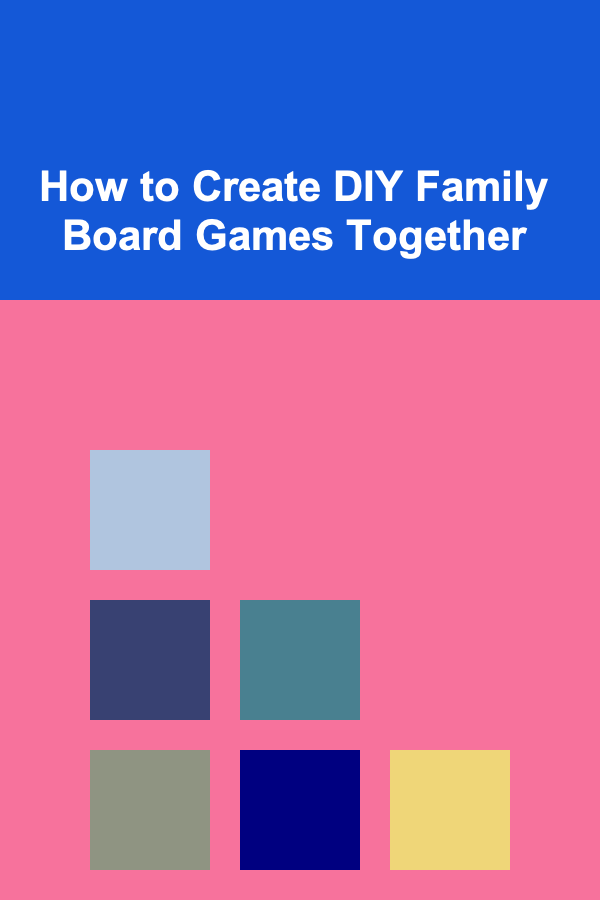
How to Create DIY Family Board Games Together
ebook include PDF & Audio bundle (Micro Guide)
$12.99$10.99
Limited Time Offer! Order within the next:

Creating DIY board games as a family can be an exciting, rewarding, and highly creative activity that brings everyone together. Not only will you bond over designing and crafting a game, but you'll also have a unique game to play together, tailored to your family's interests and tastes. Making your own board game from scratch also allows for complete customization in terms of rules, difficulty, and themes, making it a truly personalized experience.
In this article, we'll walk you through the process of creating your very own family board game from start to finish, exploring the importance of collaboration, the necessary steps to design the game, and how you can ensure that it's fun, challenging, and enjoyable for everyone.
Why Create a DIY Family Board Game?
Before diving into the process, it's helpful to understand why crafting your own board game is a worthwhile endeavor. Here are some compelling reasons why creating a DIY board game as a family can be a great project:
1. Bonding Time
Creating a board game together fosters teamwork and collaboration. Each family member will bring their own ideas, and everyone will be involved in the decision-making process. This shared experience creates a sense of togetherness that strengthens relationships.
2. Stimulating Creativity
Designing a board game challenges everyone to think creatively, whether it's coming up with an engaging theme, designing the game pieces, or crafting interesting rules. It encourages imagination and problem-solving skills, especially in children.
3. Personalization
Unlike store-bought games, DIY games are personalized to your family's interests. You can incorporate inside jokes, favorite hobbies, or family experiences into the game, making it a one-of-a-kind creation.
4. Low-Cost Fun
Making your own board game is an inexpensive project. Many of the materials required are likely to be found around the house, and with a little imagination, you can create a fantastic game without spending much money.
5. Learning Opportunity
Building a game from scratch offers a valuable learning experience. Children will learn about game mechanics, logic, strategy, and how to structure something complex while adults may enjoy reliving childhood creativity. It's an opportunity for all to learn and practice patience, perseverance, and design skills.
Step-by-Step Guide to Creating Your DIY Family Board Game
Creating a board game is a multi-step process that involves brainstorming, designing, testing, and finalizing the rules. Let's go through each stage in detail.
Step 1: Brainstorm and Choose a Theme
The first step in creating your DIY family board game is choosing a theme. This is crucial because it sets the tone and the framework for the entire game. A theme can be based on anything your family loves -- it could be something related to nature, a favorite movie, a historical period, or even a family vacation.
Questions to Ask During Brainstorming:
- What interests does the family share? (For example, animals, sports, or outer space)
- What kind of game do we want to make? (Strategy, luck-based, trivia, or action)
- Are there any personal interests or inside jokes we want to incorporate into the game?
- Do we want the game to have an educational component?
If your family enjoys adventures, perhaps a treasure hunt-style game could be interesting. If everyone is a fan of fantasy, you could base the game on magical creatures or kingdoms. Alternatively, you could design a game that's entirely abstract, where the goal is simply to move from one point to another, but with an added layer of creativity in the design of the playing pieces and the board.
Step 2: Decide on the Game Mechanics
Now that you've chosen a theme, the next step is to think about how the game will work. Game mechanics are the rules and interactions that will make the game function. Consider these important aspects:
1. Objective of the Game
What is the ultimate goal of the game? The objective should be clear and attainable for players. For example, in Monopoly, the objective is to bankrupt your opponents, while in Scrabble, the goal is to create the highest-scoring word.
2. Number of Players
How many people will be playing the game? This will influence the number of game pieces, the design of the board, and the complexity of the game. A simple game might work for two to four players, while a more complex game could involve teams or larger groups.
3. Game Type
What kind of game are you creating? Some common types of board games include:
- Strategy Games: These games require players to plan and make decisions based on logic and foresight (e.g., chess, Settlers of Catan).
- Luck-Based Games: These games rely heavily on random events or chance (e.g., Monopoly, Snakes and Ladders).
- Trivia Games: Players answer questions to advance (e.g., Trivial Pursuit).
- Cooperative Games: All players work together toward a common goal (e.g., Pandemic).
4. Turns and Movement
How do players interact with the game during their turn? Will they roll dice to move? Pick cards? Or make decisions based on the game board's layout? Define how players will advance through the game, whether it's by rolling dice, answering questions, or following a path on the board.
5. Challenges and Obstacles
What will make the game interesting? Will there be spaces on the board that represent challenges, rewards, or obstacles (like in Candy Land or Chutes and Ladders)? Are there any traps, bonus rounds, or surprises that will keep the game exciting?
Step 3: Design the Game Board
Now that you've established the mechanics, it's time to design the board. The design doesn't have to be professional, but it should be clear, visually appealing, and functional.
Materials You Will Need:
- A large piece of cardboard or poster board (for the game board itself)
- Markers, colored pencils, or pens (for drawing)
- Ruler (for precise lines)
- Glue or tape (for attaching additional elements)
- Printed or hand-drawn images (for spaces, cards, or other visuals)
Tips for Designing the Game Board:
- Keep it Simple: If it's your first time designing a board game, aim for simplicity. A winding path, like in games such as Chutes and Ladders or Candy Land, can be a great start.
- Include Spaces for Players to Land On: These spaces can represent different challenges or bonuses, like going forward, losing a turn, or picking a card.
- Incorporate Game Elements: For example, if your game is about pirates, the board could feature islands, ships, and treasures. If your theme is space exploration, the board could have planets and stars.
- Design a Border: Draw or color a border around the game to define the boundaries of the board and make it visually distinct.
- Add Special Elements: You might want to add spaces like "Go Back 3 Spaces," "Skip a Turn," or "Pick a Card" to make the game more engaging.
Step 4: Create the Game Pieces
In addition to the board, you'll need to design pieces that players can use to represent themselves. These can be as simple or elaborate as you like. Some families may decide to use everyday objects around the house, while others may want to craft unique pieces.
Materials You Will Need:
- Small objects such as coins, buttons, or beads (for player pieces)
- Paper or cardboard (to create custom player pieces)
- Glue and scissors (to cut out shapes or images for the pieces)
If you prefer to make your own pieces, you can create custom figures based on the theme of the game. For example, for a pirate-themed game, your pieces could be tiny pirate ships or characters. For a fantasy-based game, you could craft wizard figures or mythical creatures.
Step 5: Write the Rules
Now that the game board and pieces are ready, you need to write clear and easy-to-follow rules. Game rules should be simple and straightforward, but also flexible enough to accommodate different levels of play.
Basic Rule Elements:
- Setup: Explain how to set up the game, including where the pieces start and any initial requirements (e.g., each player starts with 5 cards).
- Gameplay: Outline the steps each player will take during their turn, such as rolling the dice, moving the piece, and drawing cards.
- Winning the Game: Define how a player wins, whether it's reaching a destination, accumulating the most points, or defeating an opponent.
- Special Rules: If there are any unique elements in the game (such as power-ups, events, or challenges), explain them clearly.
Be sure to test the rules with your family to ensure they are easy to follow and fun to play. Make adjustments as needed based on feedback from the group.
Step 6: Playtest the Game
Once the board and pieces are ready, it's time to test the game! Play a few rounds with your family and see how everything works. Pay attention to the following:
- Is the game too easy or too hard?
- Are there any unclear rules or mechanics that need adjustment?
- Are the challenges and obstacles fun and engaging?
Use the feedback from playtesting to make any necessary changes. Don't be afraid to tweak the game, even if it means modifying rules or redesigning elements to improve the experience.
Step 7: Final Touches
Once you're happy with how the game plays, it's time to add some final touches. You can decorate the game board, improve the appearance of the pieces, or even create an instruction manual to explain the rules.
Conclusion
Creating your own DIY family board game is a fun and fulfilling activity that promotes creativity, teamwork, and problem-solving. With a little imagination and effort, you can design a one-of-a-kind game that brings your family closer together, fostering shared memories and experiences. Whether you choose a classic board game layout, design a trivia-based game, or invent something completely new, the possibilities are endless. So gather your family, brainstorm some ideas, and start crafting your very own homemade board game today!
Reading More From Our Other Websites
- [Toy Making Tip 101] Pattern-Perfect Play: How to Choose the Right Templates for DIY Toys
- [Personal Financial Planning 101] How to Save Money Effectively Using the Best Credit Cards for Rewards
- [Organization Tip 101] How to Store Fish Finders and Electronics Safely
- [Home Lighting 101] How to Make Your Home Office More Productive with the Right Lighting
- [Star Gazing Tip 101] DIY Backyard Observatory: Building a Kid‑Friendly Telescope on a Budget
- [Home Renovating 101] How to Plan a Home Renovation on a Tight Budget
- [Personal Investment 101] Making Money from Deep Learning through Affiliate Marketing
- [Small Business 101] How to Turn Seasonal Fluctuations into Year‑Round Revenue Streams
- [Personal Financial Planning 101] How to Manage a Side Hustle Without Sacrificing Your Finances
- [Organization Tip 101] How to Use Color Coding for Different Types of Jewelry

How to Offer Music Lessons: A Comprehensive Guide
Read More
How to Use Baskets for Organizing Snacks in the Pantry
Read More
Mastering Fleet Management: Strategies and Practices for Fleet Managers
Read More
How to Meditate for Enhanced Focus
Read More
Exploring Electric Race Cars and Motorsports
Read More
How to Navigate Psychiatric Medication Management
Read MoreOther Products

How to Offer Music Lessons: A Comprehensive Guide
Read More
How to Use Baskets for Organizing Snacks in the Pantry
Read More
Mastering Fleet Management: Strategies and Practices for Fleet Managers
Read More
How to Meditate for Enhanced Focus
Read More
Exploring Electric Race Cars and Motorsports
Read More